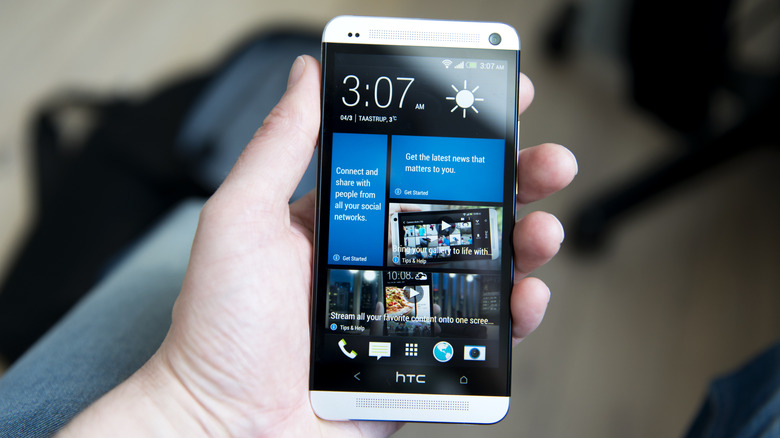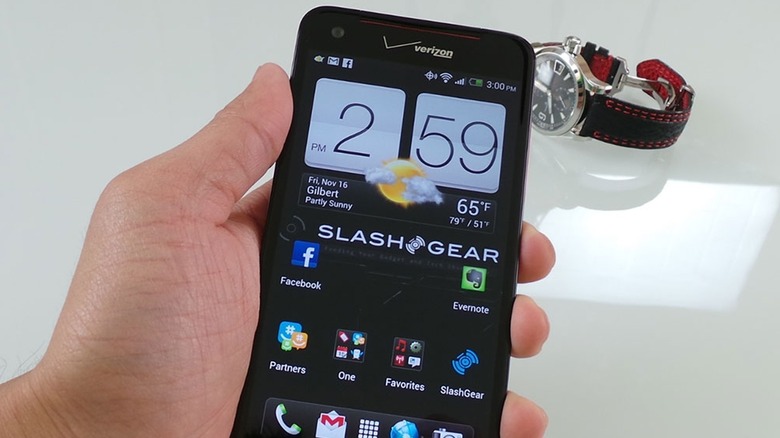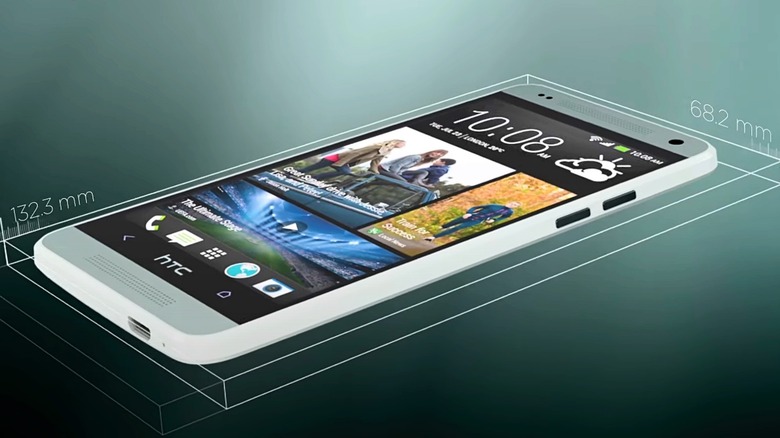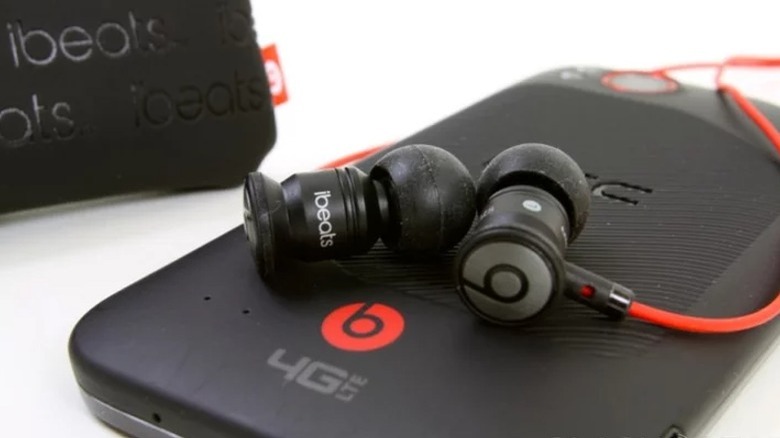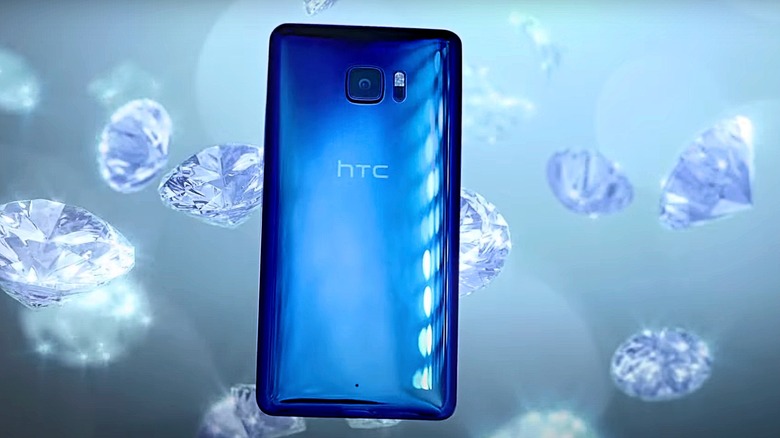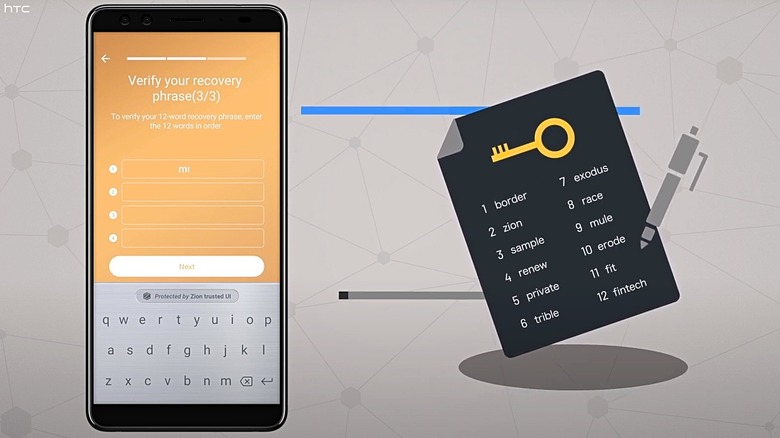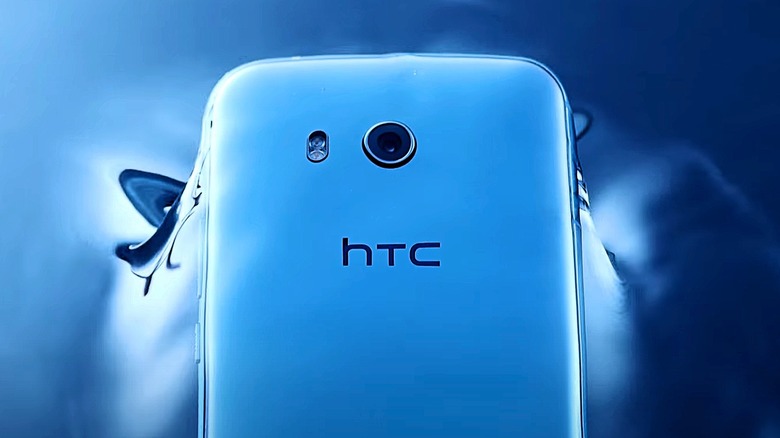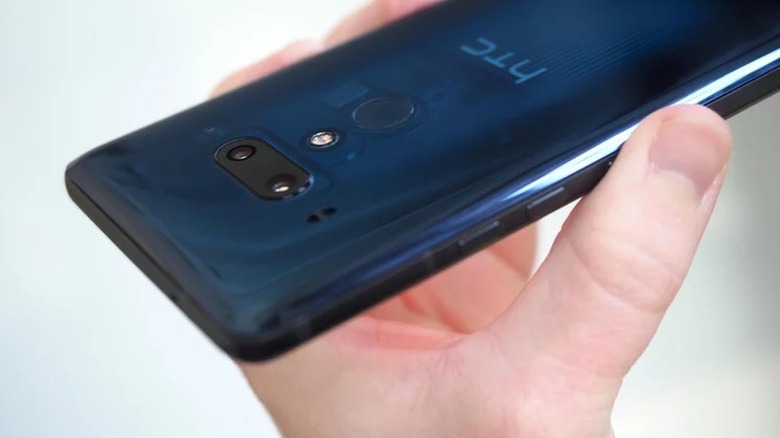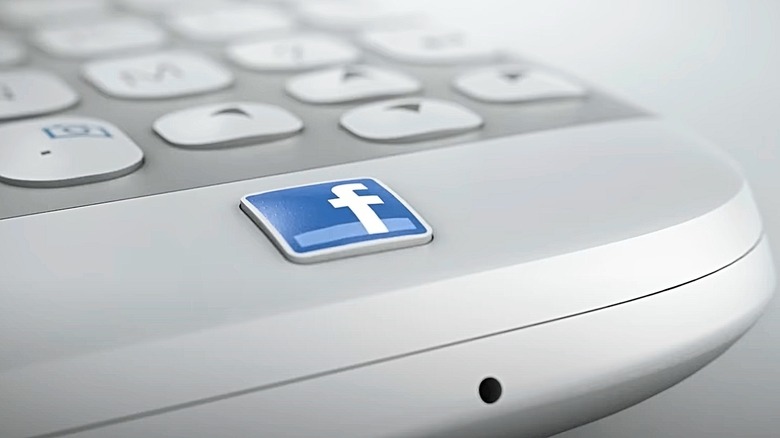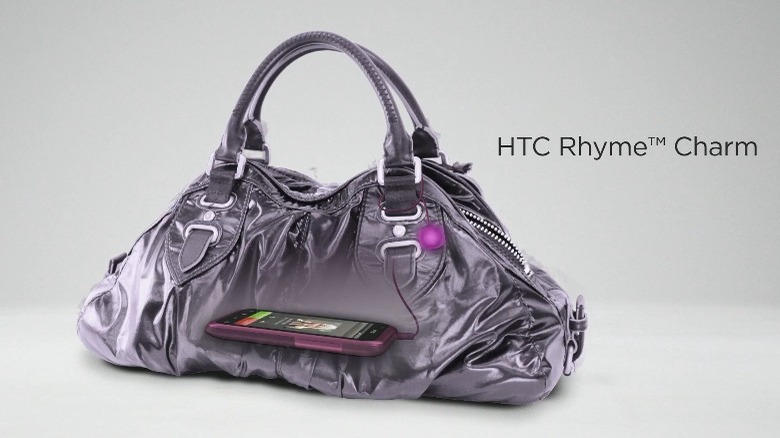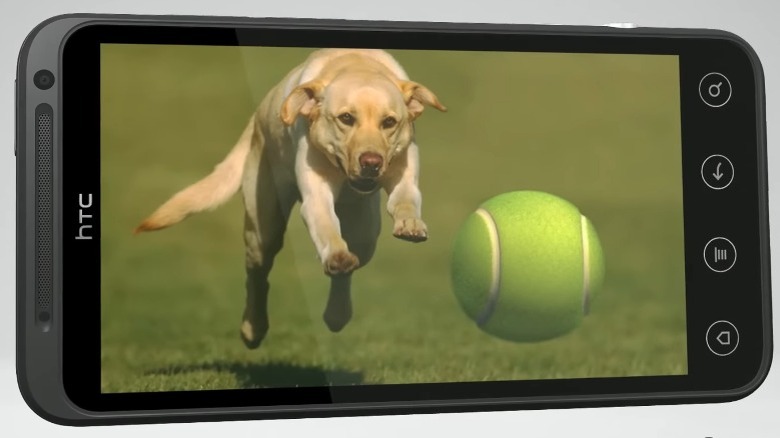10 Of HTC's Most Unexpected Android Phones, Ranked By Weirdness
HTC delivered the world its very first Android phone way back in 2008. Known as the T-Mobile G1 in the United States, the HTC Dream featured specs you wouldn't even consider smartphone-worthy these days. Still, it was a well-received phone at the time and gave us a sneak peek at what was to come.
As a pioneering force in those early Android days, HTC enjoyed a growing reputation and steady sales that peaked in the first quarter of 2011. The Taiwanese contenders surprisingly surpassed Nokia as the third-largest manufacturer of smartphones. This prompted Apple and Samsung — the first and second place smartphone manufacturers — to step up their marketing, and HTC sales began dwindling by the second half of that year.
By 2012, conquering the US market seemed like a pipe dream as Apple and Samsung sales soared. This left HTC and others picking up scraps. Lacking that must-have flagship like the iPhone 4 or the Galaxy S III, HTC looked to compensate for these shortcomings by focusing on turning out as many phones as possible while trying to deliver to various demographics. While it did produce many excellent models, this strategy also earned HTC a reputation for producing some gimmicky phones with unconventional — sometimes even bizarre — designs and features. While its approach was innovative, the results were hit or miss, and HTC eventually fell off the smartphone map.
We've researched the longevity of the wide variety of features and designs and critical and consumer reactions to them, and subjectively ranked them from least peculiar to most.
10. HTC Droid DNA
The first phone on our list wasn't exactly weird, but its superior display was somewhat unexpected. The HTC Droid DNA was the first smartphone with a 1080p resolution to be released in the US, and this stunning 5-inch display beat its rivals hands down, giving its Taiwanese manufacturers something to be chuffed about. While five inches was by no means the largest display at that time, it was still a decent size. However, it was the high resolution that elevated the Droid DNA to flagship levels. It had a 440ppi (pixel per inch) count that even that year's best-selling phones, the iPhone 5 and Samsung Galaxy S3, couldn't compete with.
In our review of the Droid DNA back in 2012, we also commented on the superb quality of the video. 1080p at 30fps again matched the best-selling phones of that year, and we noted the natural colors, deep contrast, and impressive clarity of the footage. However, this big push for a high-res display meant that the HTC Droid DNA had to compromise in other areas, which it did with its 2,020mAh battery. It offered a poor lifespan, and its non-removable status was a problem for many users who were used to swapping out whenever needed.
We also pointed out that the internal storage was just an available 11 GB with no micro SD card slot. So, it soon became apparent exactly what buyers were sacrificing. However, when you factor in that the Japanese version, the HTC J Butterfly, did have a slot, some began to wonder why there was such a sacrifice for the admittedly beautiful display.
9. HTC One Mini
The HTC One Mini wasn't a terrible phone. In fact, it was pretty decent. What was weird and unexpected about it was that it didn't prove to be that much more mini than the original HTC One. That flagship phone measured 5.41 x 2.69 inches against the Mini's 5.2 x 2.49. Both had a thickness of 0.37 inches, although the Mini weighed slightly less.
However, HTC did mess with the One Mini's specs. The display resolution was downgraded from 1080p to 720p, while the Gorilla Glass and aluminum edges that protected the One's body were missing and replaced with a plastic ring. The original One's performance was technically more powerful, too. With its Snapdragon 600 chipset against the Mini's 400, multitasking was smoother, apps loaded faster, and the gaming experience was altogether better.
Internal storage and RAM were both halved, battery capacity was reduced, and there were also glaring camera differences, such as the lack of an optical image stabilizer and a reduction in pixel resolution on both lenses. It seemed like a significant loss in specs for just a minimal loss in size. However, we noted in our 2013 review of the One Mini that there was little difference between the Full HD and HD displays. Further, the performance results were not so noticeable on a smaller display, and the HTC Mini One could also be had for a bit cheaper. So, if you had smaller hands, were on a budget, and didn't mind a few compromises, it was a fine phone to buy.
8. HTC Rezound
Before the 1080p Full HD extravaganza of the Droid DNA, there was the 720p HD spectacle of the HTC Rezound. A deluge of 720p displays hit the scene in 2011, but the Rezound was the first of that group to hit the US market. At the time, some critics proclaimed it to be one of the best displays ever seen on a smartphone. There was also 16 GB of internal storage with a dedicated micro SDHC slot providing another 16GB, and the 8MP primary camera could shoot Full HD video.
Yet, the weird thing is that HTC decided to focus on its Beats Audio feature during its marketing campaign. This strategy was unsurprising given the company's $300 million acquisition of Beats Electronics LCC the previous year. It wasn't necessarily a mistake — it's just that many saw the inclusion of this feature as an expensive marketing gimmick. You could simply turn the bass on or off, effectively making it similar to a regular bass boost function. We mentioned this, the marketing campaign, and the gimmicky nature of the Beats Audio feature in our 2012 review of the HTC Rezound. However, we were still impressed by the display and fast dual-core processor.
Thankfully, the quality of the included Beats headphones that did make it a great music player, although it is worth mentioning that they only delivered excellent audio when using the Beats software with HTC's music app. Without it, sound quality degraded. The partnership between HTC and Beats didn't last too long, as the Taiwanese company sold back half of its majority stake to Dr. Dre the following year. By 2013, HTC had sold the rest of its stake, with Apple eventually acquiring the audio specialists for a cool $3 billion in 2014.
7. HTC U Ultra
The U Ultra was far from HTC's best-received smartphone. In fact, reviews were pretty critical. While many lauded its stunning liquid surface design and display, there were just too many flaws and omissions to justify the premium price tag it had. It was the undeveloped secondary screen that most felt was a gimmick. Given the fact that the small 3,000mAh battery was driving two screens, there simply wasn't enough power in it for both. The primary screen was big at 5.7 inches, justifying its massive-for-the-time price tag. The secondary screen just added more size, and while it did have some uses, it was ultimately flagged as a gimmick.
In fairness, you could use the secondary screen — which ran along the top of the phone, just to the right of the front facing camera — to access some information without interrupting what you were doing on the primary. There were tiny icons running along the top of the display, and you could swipe along for more. You could check the weather, change a setting, or use a favored app. However, it was limited and it was tiny. If you received a long message or notification, you couldn't read it all, and what you could see was pretty small and required some eyestrain to decipher, even if you had decent vision.
We summed the HTC U Ultra up as a "flawed beauty" in our 2017 review, mentioning that the USB-C headphones frustratingly only worked with HTC phones and how waterproofing was notably omitted despite the phone being priced so highly.
6. HTC Exodus 1
The HTC Exodus 1 was HTC's brave attempt at gatecrashing the crypto-craze. It was one of the first major smartphones aimed at the blockchain and cryptocurrency market and offered some intriguing features, such as an integrated Zion crypto wallet. However, the actual decentralized app (dApp) — apps which needed blockchain technology to work — experience was relatively bare-bones, with only around 30 basic options available. The fact that you could only initially purchase the phone with Bitcoin or Ethereum also raised a few eyebrows.
While HTC did implement hardware security measures like ARM TrustZone – a secure enclave still used in modern smartphones – the multi-signature social recovery of crypto keys did rely on you giving complete trust and faith to several people. You were able to split your private keys among a few trusted contacts, meaning you had to be an excellent judge of character and not prone to falling out with your friends. However, these security measures were relatively unproven, especially when compared with cold storage options like Trezor and Ledger's hardware wallets. HTC even eventually admitted that more work was needed on its security solutions.
Overall, the HTC Exodus 1 was a niche and experimental release by the Taiwanese company. While showing innovation and keeping with the times, dedicated hardware wallets and mature security-focused solutions remain the priority of the crypto community today.
5. HTC U11
The HTC U11 is where we start to get into some of the real weirdness HTC has offered over the years. This entry is notable for its Edge Sense feature, which allowed users to perform various actions by squeezing the sides of the phone. A short squeeze opened up the camera, another took the photo, or a longer one put it into selfie mode. A squeeze and hold would trigger Google Assistant, or if you were using the keyboard, it would start the phone's voice-to-text function.
You could also customize the defaults and the required squeeze pressures. It took a bit of getting used to, but it certainly had potential. In our 2017 review of the HTC U11, we thought that this feature could take off if it offered additional squeeze gestures or enabled finer control when adjusting the pressure.
The design was also weird but in an impressive way. Its shimmering Liquid Surface two-color scheme was mesmerizing. The developers went through various stages of heating, pressing, and shaping to achieve the phone's unique, wavy and reflective design. When illuminated under light, the hues changed, and the phone was well-received as an aesthetic masterclass by HTC.
4. HTC U12+
The HTC U12+ took the gimmicky functions up a notch. Not only did it feature the second generation of squeezy Edge Sense, but it also included digital, pressure-sensitive buttons on the side of the phone that looked like real buttons but offered a weird buzz instead of a clicky haptic response to register input.
These buzzy nubs frustrated many users, as the pressure application took some effort to get the hang of and you certainly couldn't rapid-fire multiple presses to crank up the volume like you could on every other smartphone. It was also easy to inadvertently press the digi-nub when trying to squeeze the phone to access Edge Sense 2.0's box of tricks.
Among the tricks that 2.0 offered was a third customizable squeezy gesture. You could now double-tap either side, and the phone would go into one-handed mode by default, as we noted in our 2018 hands on of the HTC U12+. The phone wouldn't rotate the screen when operating single-handedly, and the display would remain active as long as you held the phone. These were decent additions, but with in-app squeezes also in effect, squeezing and tapping HTC phones was fast becoming a complex language.
3. HTC ChaCha
A phone built around Facebook with a dedicated button feels pretty out-of-place today, but the HTC ChaCha catered to a specific niche in 2011. What made it even weirder was the fact that it was released around the same time as another HTC Facebook-centric Spanish-dance-themed phone, the HTC Salsa. However, despite unimpressive sales, it wasn't the last time HTC was to foray into the Facebook-themed smartphone market, as it would dive in once again in 2013 with the HTC First.
The addition of a tiny QWERTY keyboard allowed you to punch in status updates as rapidly as any event happened. This ensured your social media circles knew precisely what you were up to with minimal delay. You could also share what you were listening to, what you were reading, or even your location with minimal fuss. However, if you were interested in what everyone else was up to on Facebook, you would have had a hard time reading the tiny 2.6-inch screen.
We commented in our 2012 HTC ChaCha review that the 5MP camera and the 480p video were largely underwhelming. However, we also said that the photos it took were "good enough for Facebook sharing," which probably wouldn't cut it these days when almost everyone is — or at least thinks they are — a professional-grade photographer with their modern smartphone cameras.
2. HTC Rhyme
Although HTC never came out and said it, many publications suggested it was pretty evident that the company targeted women in its marketing of the HTC Rhyme. Reaction to the phone was a mixed bag, eliciting a range of responses.
What drew people to the conclusion that this phone was marketed to women was the so-called charm, as dubbed by HTC, which plugged into the headphone jack. The idea was that you could throw the phone into a bag and leave the charm dangling outside. When a call or text came in, it would light up in a flurry of plum-colored drama to notify the owner that a call or message needed attention.
Something like the charm had never been seen on a smartphone before, although it wasn't likely to be seen again after its patronizing approach offended its target demographic, as reported by ZDNet at the time. Ultimately, it confirmed suspicions that HTC was trying to appeal to different customer demographics with flashy gimmicks instead of developing smartphones that could actually compete in the market. This was all but confirmed with the Rhyme's bang-average specs, which were the focus of our review of the HTC Rhyme in 2011.
However, HTC did distance itself from accusations that it was a phone designed for women. Forbes reported that during a half-hour launch event in New York, there was not a single reference to the female gender – although it's hard to think of this omission as much of a positive today. Regardless, its blatant marketing campaign that ran in several publications for women and the inclusion of matching plum accessories in the package left many people shaking their heads.
1. HTC Evo 3D
With a 4.3-inch autostereoscopic 3D screen that you could view without wearing glasses, HTC had joined LG as one of the first smartphone manufacturers to utilize 3D technology in 2011. Was it a success, or was it simply a gimmick? Well, the fact is, it did actually work — to a certain degree.
The 3D camera was made up of two 5MP lenses, with photos captured in a 5MP resolution and video in 720p. HTC utilized parallax-barrier tech to achieve its results. This involved adding an extra glass layer to enhance depth perception by delivering unique pixel sets to each eye.
However, the results were polarizing. On the one hand, it did work. On the other, it was prone to causing headaches, and the only usable viewing angle was staring directly at the screen. You also had to get the distance right, which was different for everyone. Any slight differential meant a mess of pixels or a jarring confusion of angles. This certainly made playing the built-in "Spider-Man 3D" game a challenge for some, and unplayable for others.
However, 3D aside, it was an excellent all-around phone for the time. In our 2012 review of the HTC Evo 3D, we noted that the phone's performance and qHD display were impressive and battery life was decent, as was the camera when shooting in good light. Our advice for those that did find the whole 3D affair too gimmicky? Well, you could always just switch it off.
